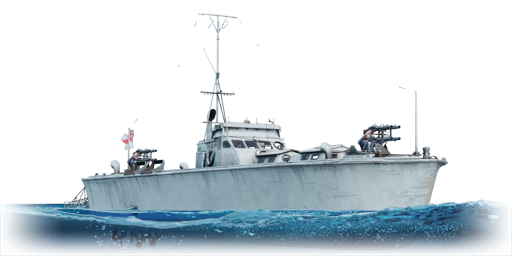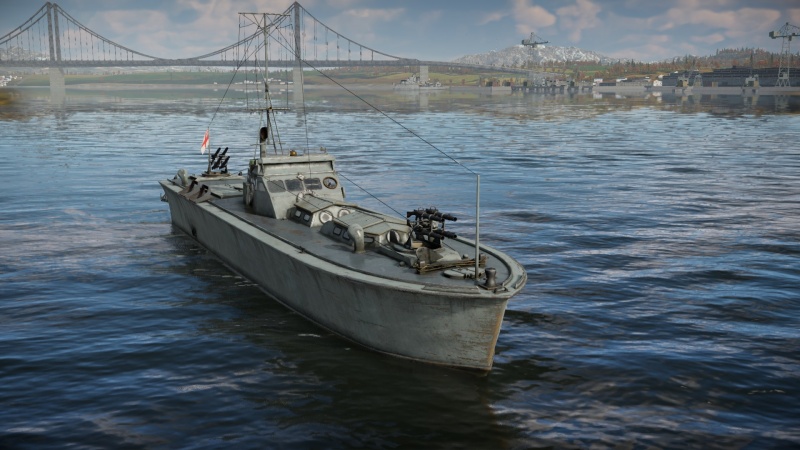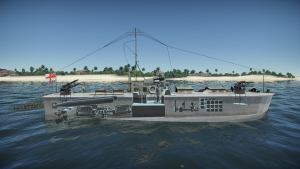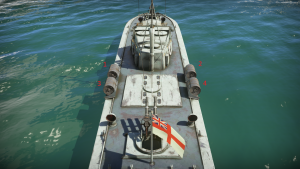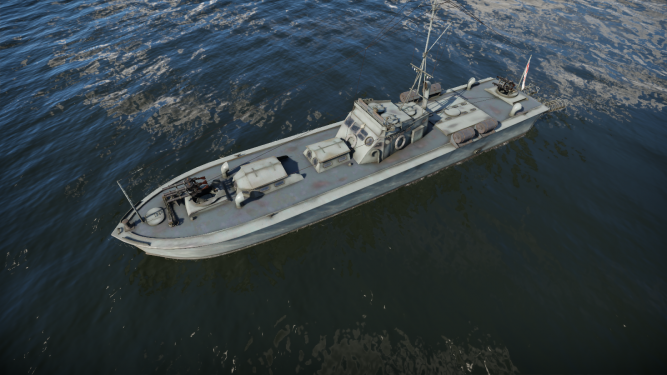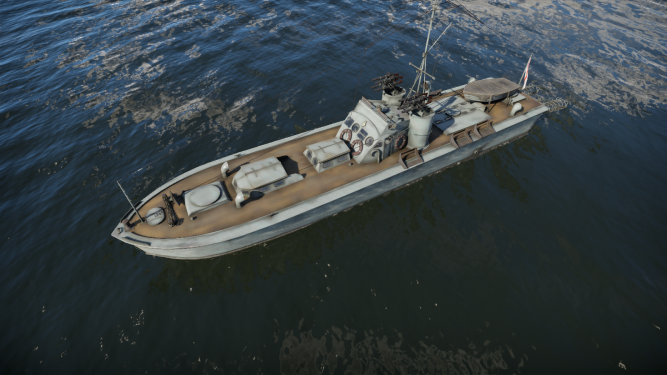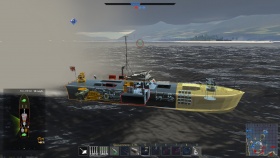Difference between revisions of "MTB-1(1)"
(Updated format) |
(Updated Description, General info to 2.5; removed hull-break description; removed in-game bug description (bug fixed); moved extraneous image to Media section and shortened caption; "compartment" -> "section") |
||
| Line 11: | Line 11: | ||
== Description == | == Description == | ||
<!-- ''In the first part of the description, cover the history of the ship's creation and military application. In the second part, tell the reader about using this ship in the game. Add a screenshot: if a beginner player has a hard time remembering vehicles by name, a picture will help them identify the ship in question.'' --> | <!-- ''In the first part of the description, cover the history of the ship's creation and military application. In the second part, tell the reader about using this ship in the game. Add a screenshot: if a beginner player has a hard time remembering vehicles by name, a picture will help them identify the ship in question.'' --> | ||
| − | The '''{{Specs|name}}''' is a rank {{Specs|rank}} British motor torpedo boat {{Battle-rating}}. It was introduced in [[Update 1.83 "Masters of the Sea"]] as part of the British fleet closed beta test. {{PAGENAME}} is the reserve vehicle | + | The '''{{Specs|name}}''' is a rank {{Specs|rank}} British motor torpedo boat {{Battle-rating}}. It was introduced in [[Update 1.83 "Masters of the Sea"]] as part of the British fleet closed beta test. With the split of the naval tech trees in [[Update "New Power"]], {{PAGENAME}} was moved to the Coastal fleet tech tree where it is now the reserve vehicle. |
| − | + | Decently fast and maneuverable, MTB-1 1 series is the Reserve vehicle of the British Coastal fleet tech tree. It carries a pair of torpedoes and sports a large number of guns, eight 7.72 mm Lewis 1916 machineguns in total. However, each machinegun individually has a poor damage output and a low effective range, so combined with her low survivability, extra caution is needed to fully utilize {{PAGENAME}}. | |
| − | |||
| − | |||
== General info == | == General info == | ||
| Line 21: | Line 19: | ||
{{Specs-Fleet-Armour}} | {{Specs-Fleet-Armour}} | ||
<!-- ''Talk about the vehicle's armour. Note the most well-defended and most vulnerable zones, e.g. the ammo magazine. Evaluate the composition of components and assemblies responsible for movement and manoeuvrability. Evaluate the survivability of the primary and secondary armaments separately. Don't forget to mention the size of the crew, which plays an important role in fleet mechanics. Save tips on preserving survivability for the "Usage in battles" section. If necessary, use a graphical template to show the most well-protected or most vulnerable points in the armour.'' --> | <!-- ''Talk about the vehicle's armour. Note the most well-defended and most vulnerable zones, e.g. the ammo magazine. Evaluate the composition of components and assemblies responsible for movement and manoeuvrability. Evaluate the survivability of the primary and secondary armaments separately. Don't forget to mention the size of the crew, which plays an important role in fleet mechanics. Save tips on preserving survivability for the "Usage in battles" section. If necessary, use a graphical template to show the most well-protected or most vulnerable points in the armour.'' --> | ||
| − | |||
| − | |||
| − | |||
| − | |||
| − | |||
| − | |||
MTB-1 1 series has the following armour layout: | MTB-1 1 series has the following armour layout: | ||
| Line 35: | Line 27: | ||
Any gun in the game will easily be able to penetrate the hull and superstructure at any practical range. | Any gun in the game will easily be able to penetrate the hull and superstructure at any practical range. | ||
| − | MTB-1 1 series can be hull-broken by any round with a large enough diameter and | + | The hull is split into three sections. The first section starts at the bow and ends after the ammunition storage; the second ends just behind the bridge; and the third ends at the stern. MTB-1 1 series can be hull-broken by any round with a large enough diameter and explosive mass. In general, this is limited to HE rounds greater with a diameter greater than 4 inches (102 mm). At MTB-1 1 series' battle rating, there is only one gun capable of hull-breaking her: |
* the [[8cwt QF Mk I (114 mm)|8cwt QF Mk I]], found on {{Specs-Link|uk_dark_class}}. | * the [[8cwt QF Mk I (114 mm)|8cwt QF Mk I]], found on {{Specs-Link|uk_dark_class}}. | ||
| Line 41: | Line 33: | ||
[[File:{{PAGENAME}}_Internals.png|thumb|{{PAGENAME}} internals (starboard). Note the ammo storage between the bridge and the forward gun mount.]] | [[File:{{PAGENAME}}_Internals.png|thumb|{{PAGENAME}} internals (starboard). Note the ammo storage between the bridge and the forward gun mount.]] | ||
| − | + | There is one ammunition storage that holds ammunition for both the fore and aft gun turrets. It is located directly behind the forward gun turret just above the waterline. Destroying it will instantly destroy the boat. | |
| − | MTB-1 1 series has | + | MTB-1 1 series has a crew complement of 11. With a stock crew, vehicle is knocked out when 7 crew are lost; with an aced crew, this is increased to 8. |
| − | + | Compared to other reserve coastal vessels, the crew complement is average. However, due to her gun placements and size, MTB-1 1 series cannot take advantage of her survivability nearly as well as some of the other reserves, making her one of the least survivable. When compared to non-reserve vessels, her survivability is rather poor. | |
=== Mobility === | === Mobility === | ||
| Line 67: | Line 59: | ||
|TurnTimeSpadedRB = 17.44 | |TurnTimeSpadedRB = 17.44 | ||
|TurnSpeedSpadedRB = 43 | |TurnSpeedSpadedRB = 43 | ||
| − | }} | + | }} |
| − | + | While her top speed is on the slower side compared to other motor torpedo boats, MTB-1 1 series' manoeuvrability is actually rather good. With a tight turning circle and a decent enough top speed, the mobility is suitable enough for most situations, although the lower top speed really hurts her potential for flanking on certain maps. | |
| − | + | MTB-1 1 series has a displacement of 22.4 tons. Because of her small size and relatively low displacement, MTB-1 1 series can be an unstable firing platform in rough waters. | |
| − | |||
| − | MTB-1 1 series has a displacement of 22.4 tons. | ||
=== Modifications and economy === | === Modifications and economy === | ||
{{Specs-Economy}} | {{Specs-Economy}} | ||
| − | + | As a reserve vehicle, the following modifications are unlocked for free: Rudder Replacement, Propeller Replacement, Engine Maintenance, Tool Set, Fire Protection System, New Pumps, and Primary Armament Targeting. | |
| + | |||
| + | The recommended modification research order is: | ||
| + | # 7.7 mm AP belt | ||
| + | # Smokescreen | ||
| + | # Artillery Support | ||
| + | # Dry-Docking | ||
| + | |||
| + | After that, research the rest of the modifications in whatever order you prefer. | ||
== Armament == | == Armament == | ||
| Line 302: | Line 300: | ||
== Media == | == Media == | ||
<!-- ''Excellent additions to the article would be video guides, screenshots from the game, and photos.'' --> | <!-- ''Excellent additions to the article would be video guides, screenshots from the game, and photos.'' --> | ||
| − | + | ||
| + | <gallery mode="nolines" widths="280px"> | ||
| + | MTB-1 damaged-1.jpg|326x326px|MTB-1 1 series defends a capture point, despite numerous damages. | ||
| + | </gallery> | ||
== See also == | == See also == | ||
Revision as of 22:50, 24 February 2021
| This page is about the British motor torpedo boat MTB-1(1). For other versions, see MTB-1 (Family). |
Contents
Description
The MTB-1 1 series is a rank I British motor torpedo boat with a battle rating of 1.0 (AB/RB/SB). It was introduced in Update 1.83 "Masters of the Sea" as part of the British fleet closed beta test. With the split of the naval tech trees in Update "New Power", MTB-1(1) was moved to the Coastal fleet tech tree where it is now the reserve vehicle.
Decently fast and maneuverable, MTB-1 1 series is the Reserve vehicle of the British Coastal fleet tech tree. It carries a pair of torpedoes and sports a large number of guns, eight 7.72 mm Lewis 1916 machineguns in total. However, each machinegun individually has a poor damage output and a low effective range, so combined with her low survivability, extra caution is needed to fully utilize MTB-1(1).
General info
Survivability and armour
MTB-1 1 series has the following armour layout:
- Hull: 24 mm, wood
- Superstructure: 2 mm, steel
Any gun in the game will easily be able to penetrate the hull and superstructure at any practical range.
The hull is split into three sections. The first section starts at the bow and ends after the ammunition storage; the second ends just behind the bridge; and the third ends at the stern. MTB-1 1 series can be hull-broken by any round with a large enough diameter and explosive mass. In general, this is limited to HE rounds greater with a diameter greater than 4 inches (102 mm). At MTB-1 1 series' battle rating, there is only one gun capable of hull-breaking her:
- the 8cwt QF Mk I, found on Dark Adventurer.
There is one ammunition storage that holds ammunition for both the fore and aft gun turrets. It is located directly behind the forward gun turret just above the waterline. Destroying it will instantly destroy the boat.
MTB-1 1 series has a crew complement of 11. With a stock crew, vehicle is knocked out when 7 crew are lost; with an aced crew, this is increased to 8.
Compared to other reserve coastal vessels, the crew complement is average. However, due to her gun placements and size, MTB-1 1 series cannot take advantage of her survivability nearly as well as some of the other reserves, making her one of the least survivable. When compared to non-reserve vessels, her survivability is rather poor.
Mobility
| Mobility Characteristics | |||||
|---|---|---|---|---|---|
| Game Mode | Upgrade Status | Maximum Speed (km/h) | Turn Time (s) | Turn Radius (m) | |
| Forward | Reverse | ||||
| AB | Stock | 63 | 32 | ~18.64 | ~35.43 |
| Upgraded | 86 | 43 | ~12.67 | ~22.41 | |
| RB/SB | Stock | 53 | 26 | ~20.77 | ~36.73 |
| Upgraded | 61 | 31 | ~17.44 | ~33.15 | |
While her top speed is on the slower side compared to other motor torpedo boats, MTB-1 1 series' manoeuvrability is actually rather good. With a tight turning circle and a decent enough top speed, the mobility is suitable enough for most situations, although the lower top speed really hurts her potential for flanking on certain maps.
MTB-1 1 series has a displacement of 22.4 tons. Because of her small size and relatively low displacement, MTB-1 1 series can be an unstable firing platform in rough waters.
Modifications and economy
As a reserve vehicle, the following modifications are unlocked for free: Rudder Replacement, Propeller Replacement, Engine Maintenance, Tool Set, Fire Protection System, New Pumps, and Primary Armament Targeting.
The recommended modification research order is:
- 7.7 mm AP belt
- Smokescreen
- Artillery Support
- Dry-Docking
After that, research the rest of the modifications in whatever order you prefer.
Armament
Primary armament
The guns are the most insufficient aspect of the MBT-1. Their range is disappointingly short, effective up to approximately 1.500 m. After that, the precision and efficiency drop significantly. Sailors firing these guns to targets on 3 km of distance could feel disappointed by the seeming vanish of their shots at the distance.
The primary armament consists of eight 7.72 mm Lewis 1916 machine guns in two quadruple mounts, one on the bow and one on the stern. There are 1,940 rounds of ammunition available for each mount, 485 rounds per gun, for a total of 3,880 rounds. Stock, the mounts can traverse horizontally and vertically at a rate of 64°/s; with the "Primary Armament Targeting" modification installed, this is increased to 75°/s. Each gun has a magazine capacity of 97 rounds and a cyclic rate of fire of 550 rounds/min. Assuming that the shots are well-aimed, this is generally more than enough to destroy many boats at this tier before having to reload, unlike some other reserve boats like G-5, Type T-14, and MAS 561.
The positioning of the turrets and their firing arc is appropriate. They allow a quick target acquisition and when coupled with decent mobility, this becomes vital through skirmishes. It is able to fire in all directions except in a ~34° arc directly behind it. The same can't be said though of the rear gun mount though. Because of the depth charge racks, even if they're empty, the rear gun cannot target any close-range targets in a ~42° arc on each side facing forwards. It also can't fire in a ~28° arc directly behind either. Because of this, MTB-1 1 series needs to show more of its side to get the rear gun mount on target, and, considering the low damage output of the guns, getting as many guns on target is a necessity.
With a stock crew, the guns can be reloaded in 18.2 seconds; with an aced crew, they can be reloaded in 14 seconds. This is rather slow compared to other guns present on rank I. Despite this, the guns have a relatively large magazine compared to other guns at this tier, 97 rounds with a rate of fire of 550 rpm. MTB-1 1 series can sustain about 10.58 seconds of fire.
- Since MTB-1 1 series has the longest reload of most reserve boat. It's always best to empty the magazines after each engagement to then reload while it's safe; getting caught out during a reload is the last thing desired to happen.
| Turrets are named sequentially, clockwise, starting at the bow |
| Primary Armament Guidance | |||
|---|---|---|---|
| No.1 Turret (fore) | No.2 Turret (aft) | ||
| Horizontal | Vertical | Horizontal | Vertical |
| ±180° | -5°/+43° | ±160° | -5°/+43° |
There are three ammunition types available:
- Universal: AP · T · AP · T
This belt offers a 50-50 distribution of armour-piercing and tracer rounds. This belt serves decently but not outstandingly, on both naval and air targets. Although, just like its distribution the efficiency is reduced by 50% depending on what the boat engages. This is because each round will have a different effect on the target since the belt is not dedicated but to all kinds of threats. Let's say MTB-1 attacks an enemy boat, only half of the belt will damage efficiently the target.
This belt is recommendable if the strategy is to be armed for all types of threats. Nonetheless, some captains consider this unwise because low magazine count combined with a long reload time of the Lewis machine guns limit the usefulness and the rapid-fire responses. So instead of this, some prefer a more dedicated belt.
- 7.7 mm AP (Armor piercing) belt: AP · AP · AP · T
This belt is comprised of a 75-25 distribution. The Armor-piercing bullets being the predominant round inside the belt produce important damage to fast crafts. This should be the favourite belt when attacking other boats. The damage to planes is reduced because the bullets could just pass through the aircraft producing no major damage unless a direct hit to some critical parts as the engine or the pilot.
The small portion of tracer might not be enough to cause any aircraft fire and not suitable to damage boats or ships efficiently. Serving principally as guidance to aiming and ballistics.
- 7.7 mm API (Armor-piercing incendiary) belt: IT · IT · IT · AP
As a result, this belt should be fully dedicated to air targets. The incendiary and tracer properties are highly adequate to target planes. Even if the gunners can't achieve a direct hit to anything critical on the aircraft. This belt could ignite on wings and fuel tanks. Anything that can burn, shall burn.
Biplanes as the German He 51 (Family) and early naval bombers such as the Japanese F1M2, are prone to catching fire. It's here when this belt provides its value. Contrastingly, this belt is the least recommendable to fight boats. The armour-piercing properties are poor and the incendiary effect is essentially lost.
Captains are free to test these belts to find what suits their strategy the best.
| Penetration Statistics | ||||||
|---|---|---|---|---|---|---|
| Ammunition | Penetration @ 0° Angle of Attack (mm) | |||||
| 10 m | 100 m | 500 m | 1,000 m | 1,500 m | 2,000 m | |
| Universal | 10 | 9 | 8 | 7 | 6 | 5 |
| 7.7 mm AP belt | 10 | 9 | 8 | 7 | 6 | 5 |
| 7.7 mm API belt | 10 | 9 | 7 | 6 | 5 | 5 |
Additional armament
MTB-1(1) has four possible loadouts:
- 2 x Mk.XII torpedo
- 4 x Mk.VII depth charge
- 2 x Mk.XII torpedo, 4 x Mk.VII depth charge
- Without load
Torpedoes
MTB-1 1 series can carry two 18 inch Mark XII torpedoes. These are carried internally in the aft of the boat and are launched through the transom tail first, i.e. facing forwards.
The 18-inch Mk.XII is fairly average in terms of maximum speed and range, though it has a rather small explosive mass compared to other torpedoes. Still, a hit with the Mk.XII torpedo is more than enough to destroy any boat. Besides that, this torpedo is unnoteworthy.
| Torpedo Characteristics | ||||||||
|---|---|---|---|---|---|---|---|---|
| Torpedo Mode | Mass (kg) | Maximum speed in water (km/h) | Travel distance (km) | Depth stroke (m) | Arming distance (m) | Explosive type | Explosive mass (kg) | TNT equivalent (kg) |
| No | 702 | 50 | 3.20 | 1 | 50 | TNT | 176 | 176 |
| Yes | 74 | 1.37 | ||||||
The Torpedo Mode modification is available as a rank IV modification. Installing it will give the following changes:
| Torpedo Mode Specification Changes | |
|---|---|
| Max Distance (m) | Max Speed (m/s) |
| -1829 | +7 |
Once unlocked, sailors can opt for always keeping the Torpedo Mode installed. The higher maximum speed is much more valuable against the fast boats of this tier, and the maps are small enough that the decreased maximum range doesn't really matter. Note that the Torpedo Mode modification on MTB-1 1 series has the opposite effect compared to most other vehicles. Typically, the maximum range is increased at the cost of speed.
If using torpedoes, be aware that, unless already launched, the torpedoes can be shot at, and there is a small chance for them to detonate if destroyed. To avoid this, fire the torpedoes early on — and after reloads in AB — or simply don't take them at all. Torpedoes are a situational weapon, so it's largely down to personal preference whether captains want to take them or not.
Depth Charges
There are not many practical reasons to use depth charges. But they usually result in a one-hit kill if used properly, even early destroyers such as the Type 1924 Leopard can be quickly decimated by one depth charge, so this really speaks about the amount of damage they are able to generate. The depth charges can also become a liability during combat; their onboard detonation will usually be fatal to the MTB-1 since they essentially act as exposed ammo racks before they're dropped.
Some will think best to equip all the lethal and useful armaments to battle, while others will prefer to not carry such delicate cargos at all. It's up to the captains to decide if the risk is worth a potential reward.
Their use is also extremely situational, this is because they require the carrying ship to get really close to the target to then release the charges. This means the depth charges won't be the ideal weapon to deal with the usual long-distance engagements. With some luck though, sailing up right next to a slower target and dropping a depth charge can lead to some success. If attempting this, remember the depth charge drop order and set the depth charge time delay to a minimum of 3 seconds, since any higher time delay will only mean that the depth charge will sink further, and thus away, from the target.
The Mk.VII depth charges are carried behind the bridge in racks, two on each side. They are dropped one at a time in the following order:
- Port, foremost
- Starboard, foremost
- Port, aftmost
- Starboard, aftmost
Before spawning, the detonation time delay can be set anywhere between 3 seconds and 10 seconds.
| Depth Charge Characteristics | |||
|---|---|---|---|
| Mass (kg) | Explosive Type | Explosive Mass (kg) | TNT Equivalent (kg) |
| 196 | TNT | 130 | 130 |
Usage in battles
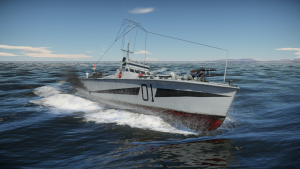
During combat, sailors must remember the MTB-1 1 series only carries enough ammunition for five reloads, so only fire when is actually possible to land the shots. This with the problem of the main guns' firing range limiting to close combats becomes a relevant gameplay factor to consider. During battles, avoid long-distance (+2 km) duels with enemy boats because MTB-1 will likely lose against them.
Certain long-distance duels are often in maps as the Black seaport and Mediterranean port. Here one of the capture points will be quite far from the main action. If the MTB-1 attempts to capture it, captains should not forget to avoid distant engagements. A common German enemy; the LS 3, outguns and outspeeds the MTB-1. Despite having a lesser crew, this type of enemy can cause a lot of trouble while the MTB's guns will be ineffective.
Some roles in which the MTB-1 Series 1 can perform:
Sea brawler
This is one of the MTB-1's strengths. With good manoeuvrability, the MTB-1 can surprise enemy boats and open fire really close to them. Using the good turning abilities to try and dodge the enemy's main guns while firing too; working with every cover to become a harder target to hit. Employ the MTB-1's mobility to sneak close and personal, using secondary armaments such as the torpedoes and depth charges to multiply the damage; is here when depth charges and torpedoes take an important role. Big targets such as the R-boots and the VAS 201 are vulnerable to them. Be aware, they can carry depth charges and mines so sometimes is better to use the torpedoes and keep the distance. Perform lighting attacks then retreating with a smoke cover back to allies.
There is also the possibility to request a battleship's main calibre artillery. This one is very important if sailors see groups of enemies seizing a point or going through a tight coastal passage. Often this artillery attacks will swing apart the fragile and light boats. Pretty remarkably sighting indeed!
Close-range aircraft interception
The MTB-1 1 series can be used to intercept enemy planes, flying boats, and bombers flying low towards allied shipping. Considering these planes sometimes will be slow, the work is pretty much doable for the MTB-01 (The guns provide immediate sustained fire, enough to track and fix the leading). Thanks to the decent turret range and mobility, the MTB-1 could always keep the enemy plane at gunpoint.
If about to be attacked by an enemy plane, the MTB-1 can disengage, turn in the opposite direction and use a smoke cover to defend. This tactic is also valuable if is needed to protect an allied ship.
An important thing to remember is to avoid firing planes out of range. This often could lead to several planes attacking overwhelmingly since the location of the MTB-1 got exposed by its own tracers. It could be wiser to wait for a closer enemy approach before opening fire.
With these tactics, captains could additionally appeal for the speed and the small silhouette of the MTB-1, attempting to avoid combat not only staying behind the allied side of the map but often going after the allied boats and ships; providing fire support and also repairing any bigger squadmate in need. Any sort of indirect fire without taking damage is the goal. Help maintain capture points or help attack points then fall back when necessary.
- On arcade, the torpedoes are particularly useful in close maps such as Andaman sea or African gulf. There MTB-1 can constantly reload torpedoes and keep launching them in numerous directions. Such as capture zones and the enemy's spawn zones; something should eventually get to them. Don't forget the disponibility of torpedo mode.
- Don't forget to destroy the whole enemy's compartments (coloured black once destroyed). Proceed to fire on other areas of the boat, once a compartment has been destroyed. This means the ammo of the MTB-1 will be used efficiently while exposing the boat to the minimum amount of damage.
- If the MTB fires at a single section of the enemy boat, is unlikely it will be destroyed. Scatter the fire tactically.
Pros and cons
Pros:
- Relatively large magazine capacity: can destroy most opponents without needing to reload
- Large volume of fire can quickly take down low-flying aircraft
- Capable of quickly achieving and sustaining usable top speed
- Surprisingly agile and with a small turn radius once fully upgraded, quite on par with the LS 4 Esau
- Third best crew count among reserve boats
- Due to large spaced compartments, it can survive relatively well
Cons:
- Only armed with small-calibre guns: low damage output per gun
- Guns are severely outranged by most of the other Rank I boats (+1.5 km)
- Longest reload of any reserve boat
- Relatively weak torpedoes (low explosive mass compared to other similar torpedoes)
- Big target compared to other smaller reserve boats; it receives alot of fire
History
Though the Royal Navy had operated a small number of coastal boats during the first World War, by the 1930s, these flotillas had long been dissolved and the Royal Navy had yet to construct any more. The first two coastal boats since WWI were ordered on 27th September 1935 by the Royal Navy, the order being given to British Power Boat Company based at Hythe, a town near Southampton. In addition to this initial order, four more were ordered on 19th October 1935. These six boats were completed by November 1936, and, with their commissioning on 27th April 1937, the Royal Navy Coastal Forces was founded. Following this, three more boats were ordered on 7th December 1936 and nine more on 11th January 1938. In total, 18 boats were ordered, all of them being completed by 1939.
These boats had a standard displacement of 18 tons and had a length of 60 ft. 4 in., a width of 13 ft. 4 in., and a drought of 2 ft. 10 in. at standard displacement. They were powered by three Napier Sea Lion petrol engines, each driving a single shaft, and could reach speeds of around 30-35 knots. Each boat could carry two 18 inch torpedoes which were stored internally on rails above the engines. On the stern were two more rails that could be folded down to the transom, extending the torpedoes' rails outside of the boat. The torpedoes fired facing forwards down the rails, after which the boat that fired them would have to turn to evade their path. In addition to torpedoes, the boats were also armed with a number of depth charges and, depending on the exact boat, up to eight Lewis guns.
MTB 1, the first of the boats, was redesignated MTB 7 in 1937. Similarly, MTB 7 was redesignated MTB 1 in the same year. In 1938, the former MTB 1, now MTB 7, was redesignated MTB 13. At the same time, MTB 13 was redesignated MTB 7. Finally, later in 1938, the former MTB 1, now MTB 13, was again redesignated MTB 19. Thus, by the start of WWII, the boats were numbered MTBs 1-12 and 14-19 and formed two MTB flotillas: 1st MTB Flotilla, consisting of MTBs 1-6 and 14-19; and 2nd MTB Flotilla, consisting of MTBs 7-12.
The 1st MTB Flotilla was sent to the Mediterranean at the start of WWII and was based at HMS Vulcan in Malta. They were soon recalled back to England in December 1939 to be based at HMS Beehive, Felixstowe, though MTB 19 was sent to HMS Vernon, Portsmouth. Along the way back, due to bad weather, MTB 6 had to be foundered. After they arrived, the remaining boats continued to operate in the English Channel until they were either lost or replaced. Those lost were MTBs 15, 16, and 17, all of which were mined in 1940.
The 2nd MTB Flotilla was commissioned in 1938 and assigned to HMS Tamar, Hong Kong. They were all lost during the Battle of Hong Kong in December 1941. MTB 8 was bombed by IJN aircraft and was damaged beyond repair, and MTB 12 was sunk in action by IJN landing craft. The remainder of the 2nd MTB Flotilla was scuttled on 26th December 1941.
Differences between close variant
The MTB-1 1 series is visually similar to 2 series, only a few minor variations are notable due to the armament placement; the depth charges and the turrets of 1916 Lewis machine guns. Technical specifications remain the same on both series, while the 2 Series receives a premium bonus.MTB-1 1 Series- 4 x Mk.VII depth charge
- Turrets are placed at the bow and stern
MTB-1 2 Series
- 6 x Mk.VII depth charge
- Turrets are placed near the bridge
- Premium
Media
See also
Similar class/series
Other contemporary British boats
External links
- unithistories.com - Royal Navy Coastal Forces 1940-1945
- naval-history.net - British vessels lost at sea in World War 2 - MGB, MTB, SGB, ML, etc - originally published in British Vessels Lost at Sea, 1935-45, His Majesty's Stationary Office, 1947
- mwadui.com - Royal Navy Coastal Forces - Hong Kong
- Coastal Forces Heritage Trust - History
- yalumba.co.uk - British Power Boat Co Page 1 and British Power Boat Co Page 5
- Wikipedia - Coastal Forces of the Royal Navy
| Britain boats | |
|---|---|
| Motor torpedo boats | Brave Borderer · Dark Aggressor · Dark Aggressor TD · Fairmile D (617) · Fairmile D (697) · Fairmile D (5001) · HMS Gay Archer |
| MTB-1(1) · MTB-1(2) · MTB Vosper · MTB Vosper(2) · MTB-422 | |
| Motor gun boats | Dark Adventurer · Fairmile A (ML100) · Fairmile B (ML345) · Fairmile C (312) · Fairmile C (332) · Fairmile D (601) · Fairmile H LCS(L)(2) |
| HMAS Arrow · HMAS Fremantle · MGB-61 · MGB-75 · ML 1383 · SGB Grey Fox · SGB Grey Goose | |
| Gunboats | HMS Spey |


